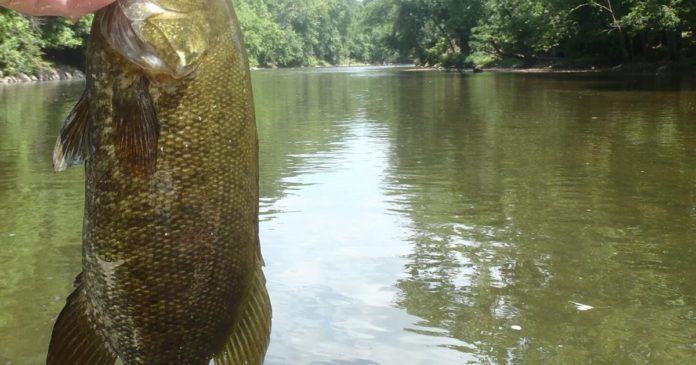The splash of a fish as it explodes on a surface lure ranks high on the list of exciting fishing moments. Summer is the time for topwater lures, whether you are fishing spinning gear or a fly rod. A popping bug is a great choice for topwater action on local rivers like the Monocacy and the Potomac to catch aggressive panfish and hard-fighting smallmouth bass.
On hot days, fish are looking up, waiting for something tasty to fall onto the water. Poppers imitate a variety of terrestrial critters such as grasshoppers, frogs, beetles, dragonflies or big spiders. It is not unusual for a fish to hot a topwater lure within only seconds after landing on the water. Just a slight twitch, is often all it takes before a fish crashes the lure.
Be prepared for action, as strikes can be vicious, with bass leaping completely out of the water as they smash the surface to take the popper. Sunfish can have a very splashy strike and often make a smacking sound as if they are kissing the popper, but not all strikes are dramatic. Fish will sometimes sip the popper and quietly pull it down beneath the surface. Stay alert and keep your eye on the lure at all times as fish can hit when you least expect it.
Recently, I discovered a new lure that is so small it can be cast easily with a fly rod. The P40 Rebel microPOP-R is an ultra-lite lure that weighs only 1/16 ounce and measures a scant 1.25 inches in length. The barbless hook removes easily from a fish’s mouth, perfect for catch and release angling.
The little lure is balanced with a small weight on its underbelly that allows the lure to ride with the hook upright. That feature makes this lure virtually weedless. It will ride over structure like logs and even lily pads with a gentle pull. The concave front creates a chugging action when retrieved in quick strips across the surface that attracts the attention of fish.
On the river
On a recent float trip on the Monocacy River, the microPOP-R was put to the test. I was fishing from a canoe on the Monocacy with my friend, Mike Moneypenny, while following another canoe with John Gallo and Jake Bise. We launched our boats early in the morning at the Monocacy Boulevard ramp and floated downstream to Pinecliff Park. It was a bright day with plenty of sunshine under a cloudless sky.
The morning started slow but the fishing action began to pick up as the day warmed and the sun rose higher. Casting the microPOP-R with my 5-weight, 9’ fly rod, I landed a number of bluegills and small bass. Many of the bluegills that attacked the lure were not big enough to successfully engulf the hook but a decent-sized bluegill was brought to hand several times that morning.
The high point of the morning occurred shortly after passing under the I-70 bridge. The majority of the fish I landed were aggressive smallmouth bass, mostly less than 10 inches in length with an occasional 12-14 incher. I was glad to see that the smaller bass were plentiful as they will grow in time. I cast the lure toward the shore and it was immediately smacked and quickly sucked under. I set the hook and felt the weight of a good fish.
The fish stayed deep and began to swim upstream. I held tight to turn the fish. The rod strained and unfortunately the line snapped! I can only guess what I had on the end of the line, maybe a heavy catfish or a huge smallie, I will never know. The one thing I do know, the microPOP-R just became my favorite topwater lure. I will need to buy more!
Topwater is not the only way to catch summer fish. In the other canoe, Jake Bise had much success fishing with a green twisty-tail grub using a spinning rod. He landed as many as 40 fish by the end of the float. I have no doubt that a wooly-bugger would have been an effective subsurface fly as well.
The fishing was typical of a summer float on the river. Fishing is always a great time spent with friends. We did not land any lunkers that morning but there is always the next outing to look forward too. The larger smallies during the summer months are more likely to be caught during low-light periods like rainy days or very early morning or late evenings. Yet, small bass and panfish can be taken with regularity even on the brightest days.
Credit: Source link































